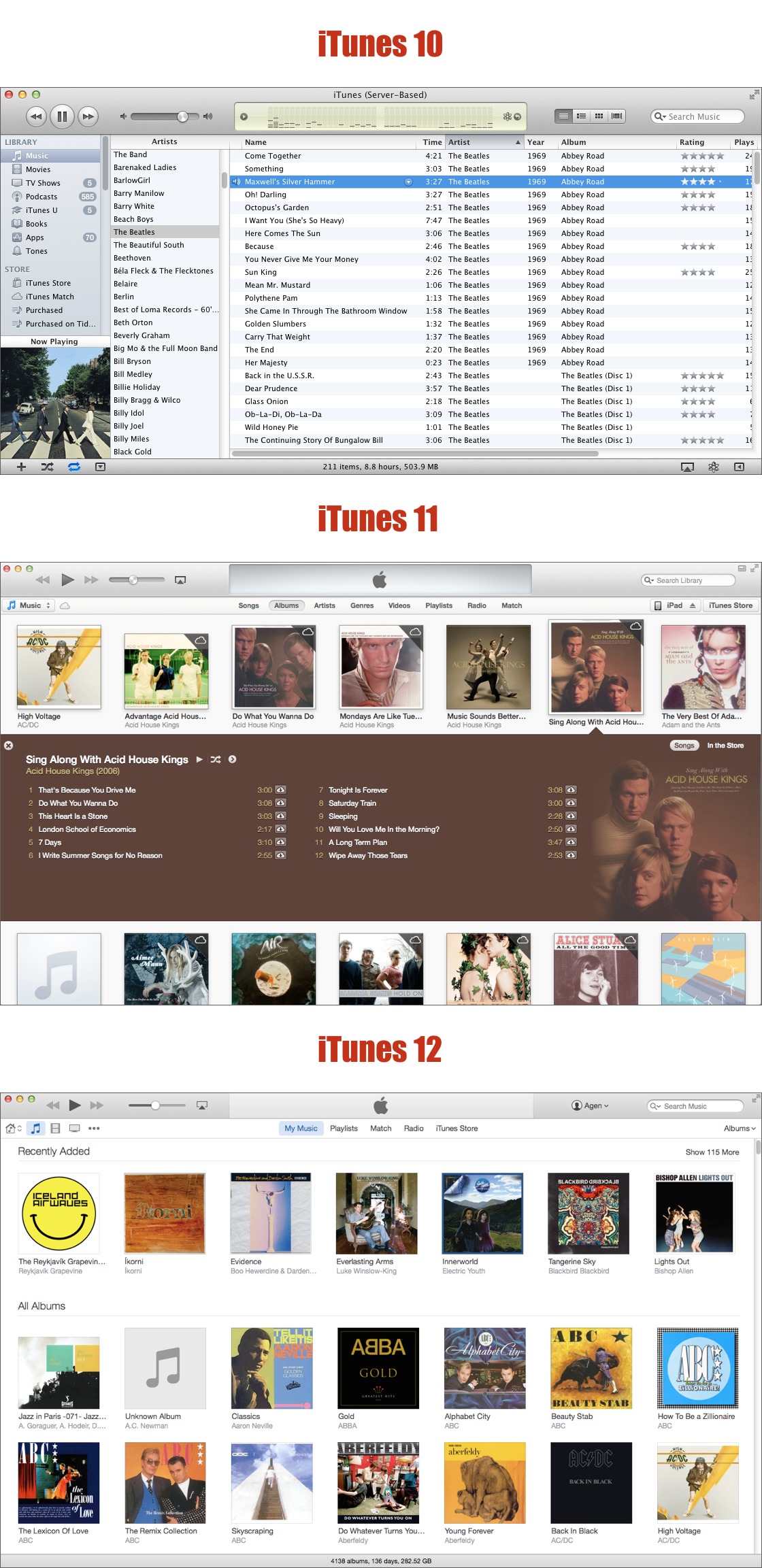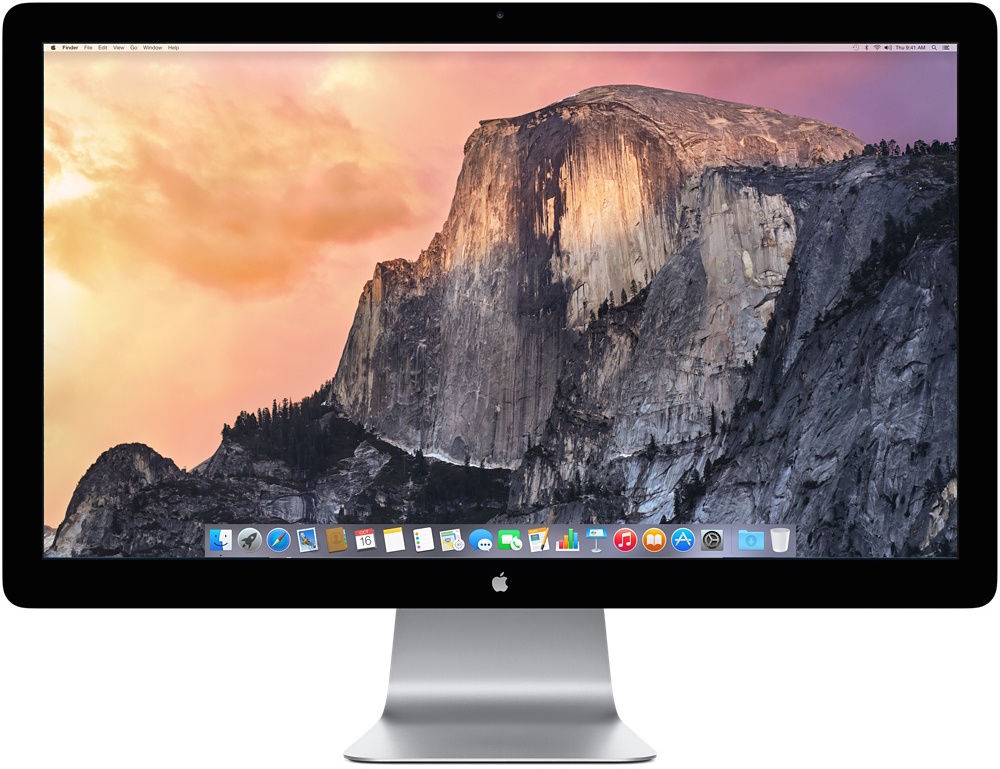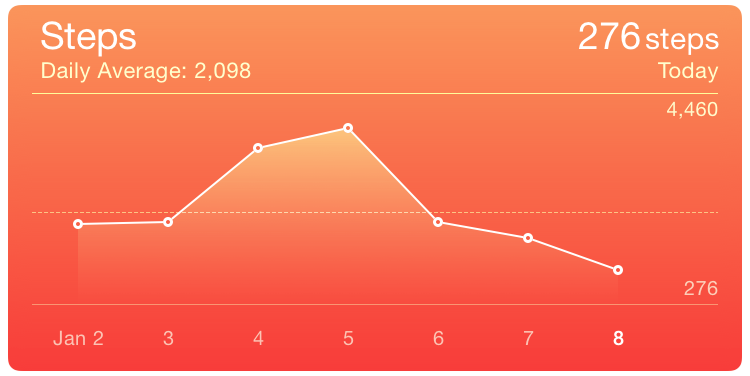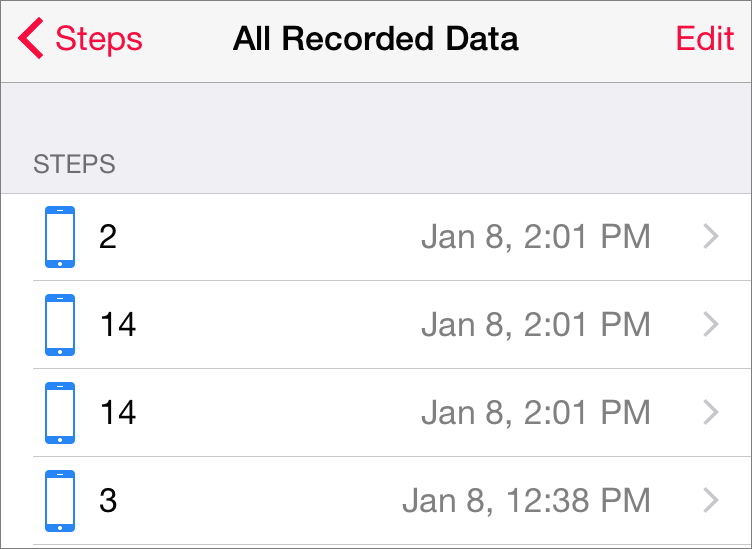The TidBITS Reader Wishlist for Apple in 2015
After publishing “The TidBITS Wishlist for Apple in 2015,” (5 January 2015), we received a lot of great feedback from readers. While most people echoed our sentiments, a number offered additional suggestions. Without further ado, here’s a selection of what TidBITS readers would like to see from Apple in 2015.
Do Something about iTunes! — Complaining about iTunes has become a common refrain for Apple enthusiasts, and we don’t disagree. Specific complaints include:
- The confusing, ever-changing interface
- General slowness
- Sync failures
- Streaming difficulties
Many users have felt for years that iTunes is terribly broken. But what no one seems to agree on is how to fix it. Considering that complaints have continued — and perhaps even accelerated — after two redesigns, it seems doubtful that Apple knows what to do either.
One approach would be to split up the functionality of iTunes among multiple apps, much as Apple did in iOS: iTunes for iTunes Store purchases, Music for music playback, Podcasts to listen to podcasts, Videos for purchased movies and TV shows, and iTunes U for educational materials. A new app would be necessary to manage syncing and backing up iOS devices. One problem with this solution is that iTunes is also available on Windows, and that would mean that those users (and Apple’s Windows developers) would have to juggle numerous apps instead of just one.
We’d settle for a return to the simplicity of older versions of iTunes. Abandon the pretty — but confusing — visual design and return to iTunes 10.7’s sortable “spreadsheet” interface with a sidebar for navigation. It may not have been as attractive as later versions of iTunes, but it was far easier to use.
A New Thunderbolt Display — In theory, Apple’s Thunderbolt Display is the perfect add-on for any Mac. Just plug in the built-in Thunderbolt connector, plus MagSafe if you’re connecting to a laptop, and you’re all set.
In reality, even if the Thunderbolt Display worked perfectly (many reports indicate that it doesn’t), it’s woefully long in the tooth. It’s still using USB 2.0, the first generation of Thunderbolt, and the original MagSafe connector, although Apple does ship it with a MagSafe 2 adapter.
A more difficult technical barrier to hurdle (due to Thunderbolt bandwidth limitations) is the fact that the Thunderbolt Display is still stuck at a mere 2560 by 1440 resolution, even as the iMac with 5K Retina display has zoomed ahead. On the industrial design side, while the iMac has slimmed down around the edges, the Thunderbolt Display is as chunky as it was in 2011. Its ergonomics remain poor as well — it tilts forward and back, but the screen height can’t be adjusted, forcing some people to stack it on books.
At $999, the Thunderbolt Display is tough to recommend. Dell makes far more adjustable displays with the same image quality and better connectivity for lower prices. If Apple is interested in the monitor game, it needs to step up to the next level. Peter Cohen of iMore agrees.
Let Us Merge Apple Accounts — Mac users who predate iCloud — and that’s a lot of people — could easily have accumulated more than one Apple ID. That was particularly true if you purchased from the online Apple Store or were dealing with your own email address changes. But with the transition from MobileMe to iCloud, Apple made the previously humble Apple ID all-important, while refusing to allow users to merge accounts (see “Apple ID Becomes Mac OS X and iCloud Glue,” 8 September 2011).
Some lucky users quickly standardized on a single Apple ID and let the others molder, but for many of us, that wasn’t possible. It’s all too easy to have one Apple ID for a heavily used iCloud account and another that had been used for all iTunes and App Store purchases. Worse, Apple sometimes required additional Apple IDs for internal reasons — we had to create yet another one to be able to publish on the iBooks Store. It’s a mess.
Sure, you can now sort of group Apple IDs together with Family Sharing, but isn’t it about time Apple let users merge all those old accounts? Alas, at this point, such an option doesn’t seem likely, but it can’t hurt to wish.
A Competitor to the Microsoft Surface — Frequent TidBITS contributor Julio Ojeda-Zapata likes his Microsoft Surface Pro (see “Microsoft Surface: A Tale of Two Computers,” 11 March 2014), which combines the functionalities of a tablet and a laptop. While that’s a tantalizing prospect, many who have tried Windows 8 have been baffled by its mixed interface, which tries to please touchscreen and mouse users equally. Several readers, tired of needing both MacBooks and iPads, suggested Apple could create a similar combination.
Apple has been firm about keeping OS X and iOS separate, but then again, Apple (in the person of Steve Jobs) also said that video on an iPod would be pointless and that no one reads anymore, only to have the company change direction entirely. And if there’s one thing Apple excels at, it’s taking half-baked ideas (MP3 players, mobile phones, and tablet computers, to name a few) and turning them into game-changing products.
While we generally ignore rumors, Mark Gurman of 9to5Mac recently wrote about a rumored 12-inch MacBook Air. This new MacBook Air would be even thinner than ever before, thanks to abandoning all but two ports: a headphone jack and a new USB-C reversible connector.
We’re skeptical that this model is in the works, or, if Apple is indeed working on that form factor, the specifics. It would be surprising to see Apple drop Thunderbolt and MagSafe for USB-C — it seems more likely that Apple would wait for Thunderbolt 3 for a combined digital data and power cable.
But here’s a wild possibility, suggested by developer Marco Arment: what if the long-rumored 12-inch iPad Pro and the now-rumored 12-inch MacBook Air are one and the same? Or perhaps that’s just random speculation — rumormonger Jack March is certain Apple isn’t making a hybrid. You can see why we so seldom cover rumors.
Improve Health — The Health app in iOS 8 promised to combine data from all of your health-tracking apps in one handy place, putting it all into beautiful charts.
Which it sort of does. Sure, it puts the data into charts, but much like Amazon sales charts, they offer little in the way of usable data. For instance, in the screenshot below, there might as well not even be a Y-axis for step data. You can see a rough chart of activity relative to each day, but there’s no baseline to determine how much each data point represents. We just know that each point represents somewhere between 276 and 4,460 steps.
Bringing up All Recorded Data is even less worthwhile, because you see either a screen with a loading spinner that never stops, or an inscrutable collection of data, added seemingly at random.
The data in the screenshot above is a perfect example. Why does Health show the steps taken at 2:01 PM in three entries rather than combining them? And why even break it down that far? An hourly summary would probably be sufficient.
Overall, the Health app is weak and sickly, but it seems like a great idea, and with some restorative design, it could be a lot more informative and useful.




Personally, I'm fine with iTunes being the central hub for music, videos, podcasts, etc. I agree with your call for a return to the iTunes 10 interface. At least as an option. I still have iTunes 11 on my main media iMac (running OS X 10.9.5). I'm dreading the day when I have to "update" it to iTunes 12. That's one of the main reasons I'm holding off on updating to Yosemite.
While I preferred the iTunes 9 interface, I was able to "muddle-through" with iTunes 10 and now 11. But if we can't go back to 9 I'd be OK with 10.
Yes! iTunes 10 was the apex of this application. I'd go back to that in a heartbeat.
The health app is so bad I can't believe it even got past quality control. Did nobody beta test it? You could have given that app to a 6 year old kid and they would have taken 2 minutes to find out what's wrong with it. In fact iOS8 has been a major disappointment for me so far - lots of nice shiny new features, but it's very unstable and full of bugs. I can't even trust my iPhone to display all notifications any more - about half the texts and emails I receive are accompanied by no notification at all.
Haven't you heard? Apple no longer does quality control. Cases in point, the OS X 10.10.1 update and the iOS 8.1 update. Yosemite itself, in spite of the most extensive beta testing in Apple's history, is still plagues with bugs, particularly around networking. Fix the Health app? Good luck with that. Apple is over-extended and under-committed on software. Their accelerated OS X development cycle is the primary culprit in my opinion.
As for fixing iTunes, when was the last time Apple actually heeded user feedback? People have been complaining about iTunes for years and every attempt Apple makes to improve it has been a setback rather than a fix.
Apple has a long history of doing what it thinks is good for users of its products whether or not users agree. But they are venturing into dangerous territory with this incessant need to keep changing how everything looks and, more importantly, how everything works. There is little doubt that the average user does not want to be constantly compelled to learn new ways of doing things they already know how to do. This strategy is seriously at odds with Apple's "it just works" image. I have been a dedicated Apple enthusiast since the early 80's, but it sure seems to me that somebody over there has a screw loose. Seriously.
I totally agree. Furthermore, the annual"major" updates acerbate not only the constant changes but also the increasing number of software bugs. Change for the sake of change seems to be the new guiding light at apple and noone seems to be paying attention to the steadily decreasing quality of the product. Add to that what is being done to the hardware, particularly in the iMac and mac Mini lines, in the ljne of reducing thickness and the ability to upgrade and Apples reputation of producing friendly products "that just work" is in serious jeopardy.
Add to all that, Apples refusal to issue even security updates if your OS is more than two years old smacks of forcing one to update the OSwhether you want to or not. All in all this does not seem to be the Apple that I fell in love with.
I think one of the problems is Jony Ives. He needs to stick with HARDWARE design and get the hell out of software design as he is totally clueless regarding the latter.
I've worked with Apple products since the late '80s, and loved them for their ease of use - until Mavericks, which has been problematic on my late-2009 21.5-inch 3.06 GHz iMac. I should've stuck with Snow Leopard, which was bulletproof.
I've been thinking about trying a clean install of Yosemite, but all the howling I'm hearing from users makes it sound like a double Mavericks with a wooden leg and a lazy eye.
Any happy converts want to try to talk me into the install?
Yes, I lament the "upgrades" of iTunes from the excellent v10 to the increasingly chaotically "pretty" versions since then. I have hundreds of classical albums in iTunes and the screens full of thumbnails are completely useless for selecting music. It took Apple ages to actually acknowledge that classical music required selection by composer rather than artist. iTunes 10 was finally a useable app easy to navigate in a similar way to the Finder that we are familiar with. It seems that the design department at Apple is now seriously out of touch, with ideas of eye candy and minimalism taking precedence over functionality and logical consistency. It's a good bet too that the excellent interface and functionality of Aperture will be thrown out in favour of PHOTOS with a dumbed-down GUI incapable of managing the tens of thousands of photos many of us now have. Come on, Jonathan Ive. Please introduce a bit more functionality into your design ideology!
I like the idea of merging legacy Apple IDs with current ones.. It is a real pain to update apps purchased with legacy IDs!
What I would really like to see is a function to kill ALL apps in one shot, instead of having to kill them one by one. If Apple won't do it, perhaps some enterprising developer could create an app to do just that - and I would gladly pay for it!
Apple has NEVER explained why they don't allow merging; after all it is done all the time with databases. Apple REALLY needs to ask a Cupertino High School student to show them how to merge databases.
Total agreement on iTunes... the current version is insane -- extremely confusing and hard to use.
Totally agree about iTunes. My new Home Theatre mac Mini came with Yosemite and I went out of my way to back rev iTunes to 10.7. Both for it's much easier GUI and for iTunes DJ, the one feature that made iTunes more than your average media player and NEVER should have been dropped. IMHO
In regard to a Thunderbolt Display refresh, Apple has a history of resting on its laurels and then letting a product die when it no longer seems viable. Benign neglect seems to be one of Apple's guiding principles. Take Aperture for example. Once a forward-looking software product, Apple let the vision die and withdrew active development after Adobe beat them on price and trial-ware policy with Lightroom. Apple caught up on both counts, but the challenge from Adobe appears to have knocked the heart out of the project.
Apple now offers a very expensive 4K Sharp monitor with the Mac Pro alongside the Thunderbolt Display. Needless to say there are many less costly 4K monitors available - and more modern Thunderbolt hubs than the TB Display provides. In point of fact, it's been a long time since Apple took monitors seriously. It's rarely been more than a token effort. That's not to say Apple couldn't do better. It merely suggests they do not care to.
1. In addition to the interface issues if Apple were to split iTunes into just two apps, video / audio (with iTunes store) and iOS connectivity, that alone would be a huge improvement.
2. The health app is useless, but it doesn't have to be!
3. I have a Dell 27" monitor which I have connected to my Mac Mini from Mini Display Port (Thunderbolt port) to Display Port, from Mini Display Port to DVI. I've never used an Apple Display so I can't compare, but I use the Dell for both computing and TV, and am delighted with the combination of monitor and computer using either connection.
4. More generally, back in the early 80's days of the Apple ][, excellent documentation was one of Apple's strengths. But then if that were still so, Take Control would be out of business. The recent Crash Course series very competently fills this big black hole.
5. In Yosemite Jonathan Ives has taken his "flat" design too far methinks. Some aspects have improved the usability, others have made it more obscure. Flat for flat's sake is a recipe for confusion.
Apple is guilty of violating that old adage, "If it ain't broke, don't fix it."